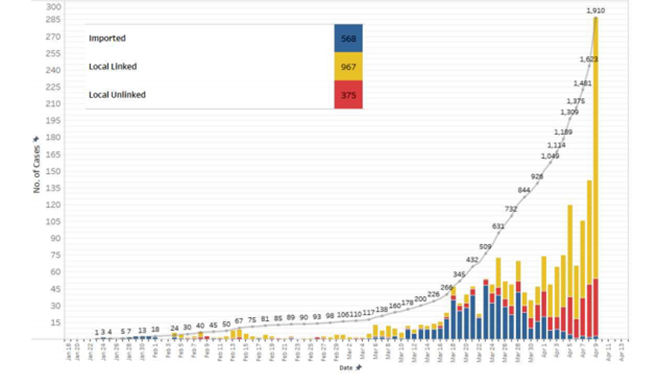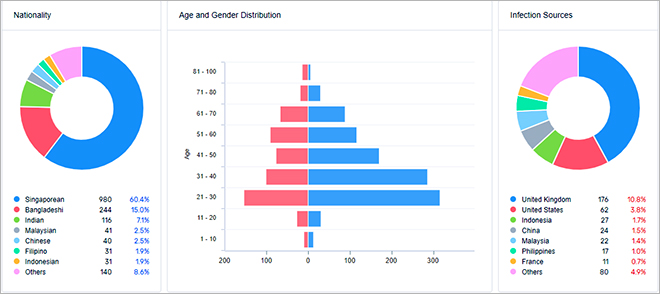
On 3 April 2020, Singapore’s Prime Minister Lee Hsein Loong addressed the nation again. He stood behind a podium with Singapore’s national emblem: Two lions dancing on both sides, with the phrase ‘Majulah Singapura’ in the middle. He started his speech in English, jumping directly into the details of the COVID-19 situation in Singapore, no sugar coating, no gaslighting. Then he drank water from a blue cup and spoke in Malay. Drank again, and spoke in Chinese. The moment he finished his address, the internet was flooded with a meme about the magical blue cup that can make you multilingual. Jokes apart, the situation in Singapore has gone worse.
Until the end of February, the daily number of new cases in Singapore was on average well below ten. Even for the first five days of March, right after my first article on Singapore’s response to COVID-19, things were looking good. However, since the first record high reporting of 13 new cases on 6 March, the average daily number of cases has increased dramatically (Figure 1). On 9 April alone, Singapore recorded 287 new cases, the highest ever. Is Singapore losing this battle? Let us hope not.
Figure 1 COVID-19 Cases in Singapore
 Source: Ministry of Health, Singapore
Source: Ministry of Health, Singapore
On the 3 April 2020, the Singapore government announced a partial lockdown, smartly called a ‘circuit breaker’, which came into effect from 7 April, 2020. The government aims to slow down the spread of the virus by only allowing services which are essential or strategic, to continue (Figure 2). Food outlets can only provide takeaways, schools have to go full e-learning and you can jog outside while keeping a safe distance from others. Economic sectors like banking, energy or manufacturing which are strategic to Singapore or the world economy, will continue to operate but with safe distancing measure in place. This will go on until 4 May, 2020.
Figure 2
 Source: Ministry of Trade and Industries, Singapore
Source: Ministry of Trade and Industries, Singapore
But these are the least of worries for people in Singapore. Recently, Singapore has been reporting a large number of COVID-19 cases which are untraceable. As of 9 April 2020, there were 357 cases for which contact tracing is ‘pending’. We all know what that means. There are people carrying the virus who we don’t know about and they might have infected more.
The government has discovered several clusters over the previous months where disease outbreaks have taken place. These include places of worship, shopping malls and private dinner parties. However, the biggest of these clusters has been discovered recently in foreign worker dormitories. These one million foreign workers are largely from Bangladesh, China and India and usually work in the construction industry. They live in packed dormitories and their unhygienic living conditions has been a major cause of the spread. It would be safe to say that Singapore is paying the price for its negligence.
Of the total number of cases in Singapore until now, 20% have been imported from different countries. The United Kingdom was the single biggest source of the virus, accounting for 10% of the total cases. The spread of the virus has not only afflicted the country’s citizens but also its large number of foreigners. While 60% of the cases are Singaporeans, 15.1% are citizens of Bangladesh, followed by 7% Indians. Interestingly, young have been more affected by the virus than old, men more than women.
Figure 3 Distribution of COVID-19 cases by nationality, age, gender and source country
 Source: againstCovid19.com
Source: againstCovid19.com
Singapore had started taking strict measures as early as January when it banned flights from China and started temperature screening in all its ports. Since then, it has progressively tightened restrictions and announced a slew of economic measures to provide cushion for its citizens. Including the latest round, Singapore’s total fiscal stimulus package stands at 60 billion dollars, which is about 12% of its GDP. Yet, the leaders of this country are tensed.
But why is this important for India? Singapore’s health care system ranks as one of the best in the world. Its bureaucracy, or technocracy if you like it, is one of the most effective. Its people one of the healthiest. Yet, this country is finding it challenging to contain the virus. India, on the other hand, is equal to about 230 Singapore’s in terms of population. With very different administrative capacity, health system resilience and health outcomes across Indian states, it is going to be a massive challenge to organize and deliver an effective response to COVID-19 as the disease spreads across the country in the coming months.
If Singapore’s situation is any indicator, we cannot take chances.
The views expressed above belong to the author(s). ORF research and analyses now available on Telegram! Click here to access our curated content — blogs, longforms and interviews.




 Source: Ministry of Health, Singapore
Source: Ministry of Health, Singapore Source: Ministry of Trade and Industries, Singapore
Source: Ministry of Trade and Industries, Singapore Source: againstCovid19.com
Source: againstCovid19.com PREV
PREV


